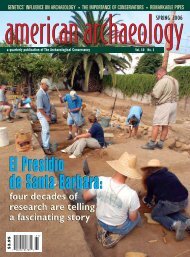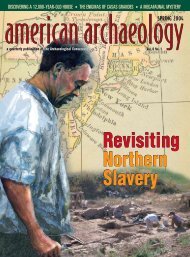Clovis Comet Debate - The Archaeological Conservancy
Clovis Comet Debate - The Archaeological Conservancy
Clovis Comet Debate - The Archaeological Conservancy
Create successful ePaper yourself
Turn your PDF publications into a flip-book with our unique Google optimized e-Paper software.
<strong>The</strong> large sandstone slab in the foreground was found in Room 4 at Site 82. <strong>The</strong> slab was discovered beneath a layer of floor mortar.<br />
dotted by piñon and juniper trees and lots of desert scrub.<br />
“<strong>The</strong>re are no permanent rivers here and we get a very short<br />
growing season with frost until about May and starting up<br />
again in September. So how did they make a living up here?<br />
And what made them leave?”<br />
<strong>The</strong>se and other questions remain unanswered, but data<br />
from Harry’s two prior digs—Lava Ridge, which she excavated<br />
in 2006, and Granary House in 2007—both of which<br />
are near Site 82, combined with evidence from this field<br />
school, have led her to hypothesize that the Shivwits people<br />
lived there year-round and that they traded their surplus<br />
pottery.<br />
<strong>The</strong> key to both assumptions, Harry said, is found in the<br />
iron-rich, deep red basalt soil. It is a distinctive volcanic material<br />
found in the ceramics at Moapa Valley sites. Research<br />
done in the late 20th century by UNLV professor emeritus<br />
Margaret Lyneis showed that Shivwits pottery had a unique<br />
signature, a combination of that red earth tempered with<br />
crushed pottery produced by people from Mount Trumbull,<br />
about 10 miles east. This pottery is much lighter-colored and<br />
contains olivine, a mineral that, in this region, is found in<br />
abundance only in the Mount Trumbull area, according to<br />
Lyneis. It’s assumed that the Shivwits people traded for the<br />
Mount Trumbull pottery, and then once it broke, crushed it<br />
to use as temper, Lyneis posits.<br />
Harry is also convinced the basaltic soil’s composition<br />
enabled it to retain water, making it sufficiently fertile for<br />
Karen Harry discusses the slab with her students prior to removing it.<br />
34 fall • 2010<br />
iSaac brekken




